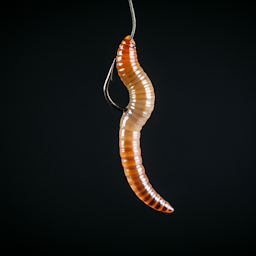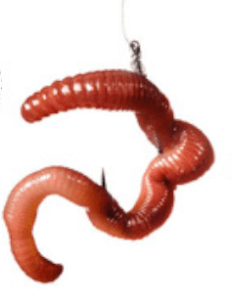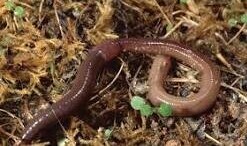Fishing with Live Earthworms or Nightcrawlers

An earthworm hooked in front
Allows natural motion when retrieving.
When it comes to fishing, there’s just something magical about using live bait, particularly worms. Almost any fish, large or small, will happily eat a live worm. Their movement and scent are just what bass are hunting for. While that is great if you are teaching young kids how to fish, it may be a disadvantage if you are targeting trophy size fish. Very often your bait will be stolen by small fish before a large one notices it. However, if you know that a large bass may be hiding under a certain dock, presenting a live tasty squirming worm might just coax it to strike, if other baits or lures have failed. Or you just might want to drop one down to a deeper hole or ledge where larger fish may be lurking.
Bass fishing is more than just a pastime; it’s an art form. Anglers take pride in their technique, equipment, and bait choices. And trust me, the bait can make or break your success out there. In this journey, using live worms effectively can elevate your bass fishing game in certain situations.
Whether you’re a seasoned angler or just starting out, understanding the nuances of live worm rigging can set you up for some real fishing success. Throughout this article, I’ll share essential tips and tricks to help you get the most out of your live worms and catch that perfect bass.
How to Rig Live Worms
Getting the rig just right with live worms can be the secret sauce to successful bass fishing. There’s some finesse involved, but with the right approach, you’ll be hooking bass in no time.
First things first, let’s talk about weight. When it comes to worm rigging, using the right weight is crucial. You don’t want something too heavy that sinks straight to the bottom or too light that it stays near the surface. A good rule of thumb is to use a weight that allows your worm to move naturally with the current or slowly reach the proper depth at which the big predator fish will be waiting. The wary fish will be looking for a worm that is gradually descending, not one that drops like a stone. Split shot weights or small bullet weights often do the trick.
Now onto the hook. Choosing the right size and type of hook can make a big difference. A size 1 or 2 hook, either worm or circle style, usually works great for bass. Make sure it’s sharp, because a dull hook won’t penetrate well, and you’ll end up losing fish. In fact, if you use a larger worm-hook, as in the picture, you may not need to add any more weight to cast the bait effectively and allow it to sink seductively.
Where you place the hook on the worm is another biggie. I prefer hooking the worm through the head similar to the picture at the top of this page.. This method allows the worm to wriggle freely, creating that natural movement bass find irresistible. I believe that method is the most realistic presentation that will fool even a smart old monster bass. But here are 2 tips that you might want to remember.
- When the worm is hooked at one end you should NOT try to set the hook as soon as you feel a bite, as you might if you were fishing a lure.. That will probably pull the hook out of the worm and allow the fish to happily swim away with the bait. Rather, give the fish time to swallow it. Often a bass will grab a live bait and, especially in the case of a live shiner or other baitfish, will turn the bait for easier swallowing. It is best to ease up on your line and wait until the bass starts running with the bait. THEN set the hook!
- Be prepared to hook onto a monster by using the right equipment and tackle to handle a big fish. I have lost many a big fish by not using the correct line strength and not changing the leader line after fighting a few fish… because each fight weakens the leader line. It is good practice to cut off the first couple feet of line and re-tying the hook every now and then.
Others swear by hooking through the midsection, which can give the worm a more erratic movement.

If you’re using longer worms, consider the threading method where the hook is inserted at multiple points along the worm’s body. While this setup does not allow the worm to move naturally, it increases your chances of a solid hookset when a bass bites.
Remember, practice makes perfect. Don’t get discouraged if your first few attempts aren’t perfect. Just keep adjusting and experimenting until you find what works best in your fishing conditions. In time, you’ll nail the perfect rig and have bass biting like never before.
Advantages of Using Live Worms for Bass Fishing
Live worms aren’t just another bait option; they can be a game-changer in the world of bass fishing in the right conditions. Their key advantage is their natural movement. When a live worm wiggles in the water, it mimics what bass would naturally hunt in their environment. This realism can trigger even the wariest of bass to strike.
Another big plus is the scent. Live worms release a natural odor that can attract bass from a distance. It’s like ringing a dinner bell, calling fish to come and take a bite. Unlike artificial lures, which rely on bright colors and erratic movements, live worms use their genuine attractiveness to lure in fish. Of course, the use of scented oils can add to the presentation of lures. But in many cases the real thing will be the ticket to success. I will cover different types of lures and techniques for using them in other articles.
Ease of availability is another win for live worms. You don’t need fancy, hard-to-find lures. Most local bait shops carry them, and if you’re up for a bit of effort, you can even dig them up in your own backyard.

Nightcrawler poking out of his hole
I fondly remember the times, as a child, I would hunt for “nightcrawlers” in the lawn with my Grandmother, who loved to fish. We would wait until dark. Then, using flashlights, we would explore the yard looking for that glistening long red body of a large worm stretching itself out on top of the grass, with the tip of it’s tail still anchored to the hole that it burrowed. You had to be quiet and fast to catch the critters. Because the worm has it’s tail still anchored in the hole, it can pull itself back quickly into the ground when disturbed. Even the light from the flashlight seems to warn the nightcrawler that danger is near. So the drill is to quietly scan with the flashlight, locate the worm, and move quickly to grab the exposed part of the worm and slowly pull it out of the hole without breaking it. Yes it takes some practice, but it can be great fun, too!
The adaptability of live worms in various water conditions can’t be beaten. Whether you’re fishing in a clear lake, a murky river, or a pond, live worms can adjust to their surroundings. Their natural behavior remains effective in different types of water, giving you a consistent edge. In fact, after a rainfall, bass in lakes and rivers will be actively searching for delicious critters that get washed into the water during a downpour. That includes everything from insects like crickets and inchworms, to salamanders and frogs along with the live worms we are now discussing. Pick the right time and you could experience the time of your fishing life using live bait!
Finally, using live worms can be more forgiving for anglers still sharpening their casting and retrieval skills. The worm does a lot of the work for you, attracting bass simply by being in the water and doing what it does best: wriggling around. It’s a fantastic confidence booster for beginners and a reliable option for seasoned pros.
Disadvantages of Using Live Worms for Bass Fishing
As with any bait, live worms come with their own set of drawbacks. One common gripe is the maintenance and storage. Keeping worms alive and lively isn’t always easy, especially in hot or cold weather. They require a cool, moist environment, which can be tricky to maintain on a long fishing trip.
Another downside is the mess. Handling live worms can be a bit icky for some people. Dirt and worm slime can make for a muddy combo that isn’t everyone’s cup of tea. Plus, there’s the occasional escapee to deal with, leading to a squirmy situation in your tackle box.
Live worms also have a knack for attracting more than just bass. Sunfish, bluegill, and even catfish can take a liking to your bait, sometimes leading to unwanted catches. This can be frustrating if you’re specifically targeting bass and end up with fish you hadn’t intended to catch. But the payoff when a large Bass hits the worm is often worth the hassle.
Cost is another consideration. Over time, purchasing live worms can add up, especially compared to artificial lures that can be reused. An unexpected expense here and there might not break the bank, but it’s something to think about if you fish frequently.
Lastly, live worms can be less durable than you’d like. They can get torn apart by smaller fish or just through the process of casting and retrieving. This means you’ll be re-baiting your hook more often, which takes time away from actual fishing.
Where to Find and How to Store Live Worms
Finding live worms is pretty straightforward. Local bait shops are usually stocked up, especially during peak fishing seasons. These shops often have worms that are already primed for fishing, which can save you time and effort.
For the DIY angler, digging in your backyard is another option. Worms love damp, rich soil, so check in shady, moist areas. You can also try looking under rocks or logs where the soil is loose and easy to sift through. Just remember to bring a small shovel and a container to keep your finds.

Salamander
As a boy, when fishing my local Trout stream, I remember turning over rocks and digging through muck to find bait. Along with worms I often found salamanders and crickets which can also be used as bait.
Proper storage is key to keeping your worms lively and enticing. A simple Styrofoam or plastic container with some damp soil or bedding material works well. Make sure to replace the soil regularly and avoid direct sunlight, which can dry out the soil and overheat the worms.
Humidity is your friend here. Keeping the soil slightly moist ensures the worms stay comfortable. If you notice the soil getting dry, just sprinkle a bit of water to freshen it up. Be careful not to overdo it though; you don’t want to drown your bait.
Temperature control is equally important. Worms prefer cool environments, ideally between 50 and 60 degrees Fahrenheit. Storing them in a refrigerator can work, but keep them away from the freezer section to avoid killing the bait.
Incorporating these storage tips will ensure that your worms remain active and appealing for the longest time. With a little bit of care, you’ll have a steady supply of live bait ready to snag those bass.
Conclusion
Some Bass anglers scoff at the use of Live Bait for catching trophy fish. I, on the other hand, believe in doing whatever it takes to catch large Bass depending on the conditions at hand on any given day or night. Yes I do also use lures, and enjoy that too. For me, being on the water is its own reward. Catching a Trophy Bass is icing on the cake.
Tight Lines my friend.
John
